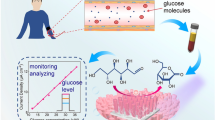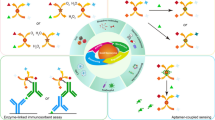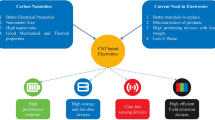Abstract
Protein-based electronics is one of the growing areas of bio-nanoelectronics, where novel electronic devices possessing distinctive properties are being fabricated using specific proteins. Furthermore, if the bio-molecule is analysed amidst different electrodes, intriguing properties are elucidated. This research article investigates the electron transport properties of l-aspartic acid (i.e. l-amino acid) bound to symmetrical electrodes of gold, silver, copper, platinum and palladium employing NEGF-DFT approach using self-consistent function. The theoretical work function of different electrodes is calculated using local density approximation and generalized gradient approximation approach. The calculated work function correlates well with the hole tunneling barrier and conductance of the molecular device, which further authenticate the coupling strength between molecule and electrode. Molecule under consideration also exhibits negative differential resistance region and rectification ratio with all the different electrodes, due to its asymmetrical structure. The molecular device using platinum electrodes exhibits the highest peak to valley ratio of 1.38 and rectification ratio of 3.20, at finite bias. The switching characteristics of different molecular device are justified with detailed transmission spectra and MPSH. These results indicate that l-aspartic acid and similar biomolecule can be vital to the growth of Proteotronics.



Similar content being viewed by others
Data availability
Not applicable.
Code availability
Not applicable.
References
Amdursky N, Marchak D, Sepunaru L et al (2014) Electronic transport via proteins. Adv Mater. https://doi.org/10.1002/adma.201402304
Chi Q, Farver O, Ulstrup J (2005) Long-range protein electron transfer observed at the single-molecule level: In situ mapping of redox-gated tunneling resonance. Proc Natl Acad Sci U S A. https://doi.org/10.1073/pnas.0508257102
Alessandrini A, Facci P (2016) Electron transfer in nanobiodevices. Eur Polym J. https://doi.org/10.1016/j.eurpolymj.2016.03.028
Blumberger J (2015) Recent advances in the theory and molecular simulation of biological electron transfer reactions. Chem Rev 115:11191–11238. https://doi.org/10.1021/ACS.CHEMREV.5B00298
Baldacchini C, Bizzarri AR, Cannistraro S (2016) Electron transfer, conduction and biorecognition properties of the redox metalloprotein Azurin assembled onto inorganic substrates. Eur Polym J 83:407–427. https://doi.org/10.1016/J.EURPOLYMJ.2016.04.030
Livshits GI, Stern A, Rotem D et al (2014) Long-range charge transport in single G-quadruplex DNA molecules. Nat Nanotechnol. https://doi.org/10.1038/nnano.2014.246
Xiang L, Palma JL, Bruot C et al (2015) Intermediate tunnelling-hopping regime in DNA charge transport. Nat Chem. https://doi.org/10.1038/nchem.2183
Macchia E, Alberga D, Manoli K et al (2016) Organic bioelectronics probing conformational changes in surface confined proteins. Sci Rep. https://doi.org/10.1038/srep28085
Baîldea I (2013) Important insight into electron transfer in single-molecule junctions based on redox metalloproteins from transition voltage spectroscopy. J Phys Chem C. https://doi.org/10.1021/jp408873c
Yamana K (2017) Gating electrical transport through DNA. DNA Supramol Chem Nanotechnol 79–93. https://doi.org/10.1002/9781118696880.CH2.1
Maruccio G (2012) Protein transistors strike gold. Nat Nanotechnol 73(7):147–148. https://doi.org/10.1038/nnano.2012.27
Rinaldi R, Biasco A, Maruccio G et al (2002) Solid-state molecular rectifier based on self-organized metalloproteins. Adv Mater. https://doi.org/10.1002/1521-4095(20021016)14:20%3c1453::AID-ADMA1453%3e3.0.CO;2-C
Alfinito E, Reggiani L, Pousset J (2015) Proteotronics: electronic devices based on proteins. Lect Notes Electr Eng 319:3–7. https://doi.org/10.1007/978-3-319-09617-9_1
Wierzbinski E, Venkatramani R, Davis KL et al (2013) The single-molecule conductance and electrochemical electron-transfer rate are related by a power law. ACS Nano. https://doi.org/10.1021/nn401321k
Venkatramani R, Wierzbinski E, Waldeck DH, Beratan DN (2014) Breaking the simple proportionality between molecular conductances and charge transfer rates. Faraday Discuss. https://doi.org/10.1039/c4fd00106k
Ruiz MP, Aragonès AC, Camarero N, et al (2017) Bioengineering a single-protein junction. J Am Chem Soc 139:15337–15346. https://doi.org/10.1021/JACS.7B06130
Bostick CD, Mukhopadhyay S, Pecht I, et al (2018) Protein bioelectronics: a review of what we do and do not know. Reports Prog Phys 81:026601. https://doi.org/10.1088/1361-6633/AA85F2
Wang H, Liu F, Dong T et al (2018) Charge-transfer knowledge graph among amino acids derived from high-throughput electronic structure calculations for protein database. ACS Omega. https://doi.org/10.1021/acsomega.8b00336
Oh S, Rubin JB, Bennett MVL et al (1999) Molecular determinants of electrical rectification of single channel conductance in gap junctions formed by connexins 26 and 32. J Gen Physiol. https://doi.org/10.1085/jgp.114.3.339
Ing NL, El-Naggar MY, Hochbaum AI (2018) Going the distance: long-range conductivity in protein and peptide bioelectronic materials. J Phys Chem B 122:10403–10423. https://doi.org/10.1021/ACS.JPCB.8B07431
Metzger RM (2003) One-molecule-thick devices: rectification of electrical current by three Langmuir-Blodgett monolayers. Synth Met 137:1499–1501. https://doi.org/10.1016/S0379-6779(02)01202-X
Krzeminski C, Delerue C, Allan G et al (2001) Theory of electrical rectification in a molecular monolayer. Phys Rev B - Condens Matter Mater Phys. https://doi.org/10.1103/PhysRevB.64.085405
Reichert J, Ochs R, Beckmann D et al (2002) Driving current through single organic molecules. Phys Rev Lett. https://doi.org/10.1103/PhysRevLett.88.176804
Ganji MD, Aghaie H, Gholami MR (2008) Theoretical study of the electron transport through the cysteine amino acid nanomolecular wire. Int J Nanosci. https://doi.org/10.1142/s0219581x08005225
Zhou YH, Zheng XH, Xu Y, Zeng ZY (2006) Current rectification by asymmetric molecules: an ab initio study. J Chem Phys. https://doi.org/10.1063/1.2409689
Sikri G, Sawhney RS (2020) First principle approach to elucidate transport properties through l-glutamic acid-based molecular devices using symmetrical electrodes. J Mol Model. https://doi.org/10.1007/s00894-020-4323-x
Chothia C (1991) Asymmetry in protein structures. Ciba Found Symp 162. https://doi.org/10.1002/9780470514160.CH4
Kojić-Prodić B, Štefanić Z (2010) Symmetry versus asymmetry in the Molecules of life: homomeric protein assemblies. Symmetry (Basel). https://doi.org/10.3390/sym2020884
Honey CR, Miljkovic Z, Macdonald JF (1985) Ketamine and phencyclidine cause a voltage-dependent block of responses to l-aspartic acid. Neurosci Lett. https://doi.org/10.1016/0304-3940(85)90414-8
Teschke O, Soares DM (2016) Chiral asymmetric structures in aspartic acid and valine crystals assessed by atomic force microscopy. Langmuir. https://doi.org/10.1021/acs.langmuir.6b00092
Cordes M, Köttgen A, Jasper C et al (2008) Influence of amino acid side chains on long-distance electron transfer in peptides: electron hopping via “stepping stones.” Angew Chemie - Int Ed. https://doi.org/10.1002/anie.200705588
Zotti LA, Bednarz B, Hurtado-Gallego J et al (2019) Can one define the conductance of amino acids? Biomolecules. https://doi.org/10.3390/biom9100580
Ganji MD (2009) Density functional theory based treatment of amino acids adsorption on single-walled carbon nanotubes. Diam Relat Mater. https://doi.org/10.1016/j.diamond.2008.11.021
Li WQ, Huang B, Huang ML et al (2017) Detecting electron transport of amino acids by using conductance measurement. Sensors (Switzerland). https://doi.org/10.3390/s17040811
Zhao Y, Ashcroft B, Zhang P et al (2014) Single-molecule spectroscopy of amino acids and peptides by recognition tunnelling. Nat Nanotechnol. https://doi.org/10.1038/nnano.2014.54
Ohshiro T, Tsutsui M, Yokota K et al (2014) Detection of post-translational modifications in single peptides using electron tunnelling currents. Nat Nanotechnol. https://doi.org/10.1038/nnano.2014.193
An YP, Yang CL, Wang MS et al (2010) Ab initio investigations of the charge transport properties of endohedral M@C20 (M = Na and K) metallofullerenes. Chinese Phys B. https://doi.org/10.1088/1674-1056/19/11/113402
Shah A, Adhikari B, Martic S, et al (2015) Electron transfer in peptides. Chem Soc Rev 44:1015–1027. https://doi.org/10.1039/C4CS00297K
Zotti LA, Cuevas JC (2018) Electron transport through homopeptides: are they really good conductors? ACS Omega. https://doi.org/10.1021/acsomega.7b01917
Minoura N (1998) Nonlinear resistance behavior of current-voltage characteristics in polypeptide membranes with conformational transition. Langmuir. https://doi.org/10.1021/la970666f
Malaspina T, Fileti EE, Colherinhas G (2017) Elucidating the stability of bolaamphiphilic polypeptide nanosheets using atomistic molecular dynamics. Phys Chem Chem Phys. https://doi.org/10.1039/c7cp06284b
De Ferra F, Rodriguez F, Tortora O, et al (1997) Engineering of peptide synthetases. Key role of the thioesterase-like domain for efficient production of recombinant peptides. J Biol Chem. https://doi.org/10.1074/jbc.272.40.25304
Deng XQ, Zhou JC, Zhang ZH et al (2009) Electrode metal dependence of the rectifying performance for molecular devices: a density functional study. Appl Phys Lett 95:103113. https://doi.org/10.1063/1.3205114
Cho Y, Kim WY, Kim KS (2009) Effect of electrodes on electronic transport of molecular electronic devices. J Phys Chem A 113:4100–4104. https://doi.org/10.1021/jp810467q
Parashar S, Srivastava P, Pattanaik M (2013) Electrode materials for biphenyl-based rectification devices. In: Journal of Molecular Modeling. Springer, pp 4467–4475
Natori K (2015) Nonideality of drain electrode and ballistic performance of MOSFET. Jpn J Appl Phys. https://doi.org/10.7567/JJAP.54.044102
Landauer R (2010) Spatial variation of currents and fields due to localized scatterers in metallic conduction. IBM J Res Dev. https://doi.org/10.1147/rd.13.0223
Xiang D, Jeong H, Lee T, Mayer D (2013) Mechanically controllable break junctions for molecular electronics. Adv Mater 25:4845–4867. https://doi.org/10.1002/ADMA.201301589
Mathew PT, Fang F (2018) Advances in molecular electronics: a brief review. Engineering
Böhler T, Grebing J, Mayer-Gindner A et al (2004) Mechanically controllable break-junctions for use as electrodes for molecular electronics. Nanotechnology. https://doi.org/10.1088/0957-4484/15/7/054
Burke K (2016) Improving electronic structure calculations. Physics (College Park Md). https://doi.org/10.1103/physics.9.108
Van Mourik T, Bühl M, Gaigeot MP (2014) Density functional theory across chemistry, physics and biology. Philos Trans R Soc A Math Phys Eng Sci. https://doi.org/10.1098/rsta.2012.0488
Smidstrup S, Markussen T, Vancraeyveld P et al (2020) QuantumATK: an integrated platform of electronic and atomic-scale modelling tools. J Phys Condens Matter 32:15901
Perdew JP, Burke K, Ernzerhof M (1996) Generalized gradient approximation made simple. Phys Rev Lett 77:3865–3868. https://doi.org/10.1103/PhysRevLett.77.3865
Xu X, Goddard WA (2004) The extended Perdew-Burke-Ernzerhof functional with improved accuracy for thermodynamic and electronic properties of molecular systems. J Chem Phys. https://doi.org/10.1063/1.1771632
Kaschner R, Hohl D (1998) Density functional theory and biomolecules: a study of glycine, alanine, and their oligopeptides. J Phys Chem A. https://doi.org/10.1021/jp980975u
Zhang Z, Xu Z, Yang Z et al (2013) The stabilization effect of dielectric constant and acidic amino acids on arginine-arginine (Arg-Arg) pairings: database survey and computational studies. J Phys Chem B. https://doi.org/10.1021/jp4001658
Chen X, Gao P, Guo L, Zhang S (2015) Graphdiyne as a promising material for detecting amino acids. Sci Rep. https://doi.org/10.1038/srep16720
Troullier N, Martins JL (1991) Efficient pseudopotentials for plane-wave calculations. Phys Rev B. https://doi.org/10.1103/PhysRevB.43.1993
De Waele S, Lejaeghere K, Sluydts M, Cottenier S (2016) Error estimates for density-functional theory predictions of surface energy and work function. Phys Rev B. https://doi.org/10.1103/PhysRevB.94.235418
Niemantsverdriet JW (2007) Appendix: metal surfaces and chemisorption. Spectrosc Catal 297–320. https://doi.org/10.1002/9783527611348.app1
Derry GN, Kern ME, Worth EH (2015) Recommended values of clean metal surface work functions. J Vac Sci Technol A Vacuum, Surfaces, Film. https://doi.org/10.1116/1.4934685
Chelvayohan M, Mee CHB (1982) Work function measurements on (110), (100) and (111) surfaces of silver. J Phys C Solid State Phys. https://doi.org/10.1088/0022-3719/15/10/029
Patra A, Bates JE, Sun J, Perdew JP (2017) Properties of real metallic surfaces: effects of density functional semilocality and van der Waals nonlocality. Proc Natl Acad Sci U S A. https://doi.org/10.1073/pnas.1713320114
Bocquet ML, Rappe AM, Dai HL (2005) A density functional theory study of adsorbate-induced work function change and binding energy: olefins on Ag(111). Mol Phys 103:883–890. https://doi.org/10.1080/00268970412331333609
Sun J, Remsing RC, Zhang Y et al (2016) Accurate first-principles structures and energies of diversely bonded systems from an efficient density functional. Nat Chem. https://doi.org/10.1038/nchem.2535
Giese TJ, York DM (2010) Density-functional expansion methods: evaluation of LDA, GGA, and meta-GGA functionals and different integral approximations. J Chem Phys. https://doi.org/10.1063/1.3515479
Jakobi K (2005) 3.1.2.4 Work function data. In: Electronic and Vibrational Properties. Springer-Verlag, pp 56–68
Pescia D, Meier F (1982) Spin polarized photoemission from gold using circularly polarized light. Surf Sci 117:302–309. https://doi.org/10.1016/0039-6028(82)90512-X
Fall C, Binggeli N, Baldereschi A (2000) Work-function anisotropy in noble metals: contributions from d states and effects of the surface atomic structure. Phys Rev B - Condens Matter Mater Phys 61:8489–8495. https://doi.org/10.1103/PhysRevB.61.8489
Singh-Miller NE, Marzari N (2009) Surface energies, work functions, and surface relaxations of low-index metallic surfaces from first principles. Phys Rev B - Condens Matter Mater Phys 80:235407. https://doi.org/10.1103/PhysRevB.80.235407
Farnsworth HE, Winch RP (1940) Photoelectric work functions of (100) and (111) faces of silver single crystals and their contact potential difference. Phys Rev 58:812–819. https://doi.org/10.1103/PhysRev.58.812
Tran R, Li XG, Montoya JH et al (2019) Anisotropic work function of elemental crystals. Surf Sci 687:48–55. https://doi.org/10.1016/j.susc.2019.05.002
Haas GA, Thomas RE (1977) Work function and secondary emission studies of various Cu crystal faces. J Appl Phys 48:86–93. https://doi.org/10.1063/1.323329
Salmern M, Ferrer S, Jazzar M, Somorjai GA (1983) Photoelectron-spectroscopy study of the electronic structure of Au and Ag overlayers on Pt(100), Pt(111), and Pt(997) surfaces. Phys Rev B 28:6758–6765. https://doi.org/10.1103/PhysRevB.28.6758
Da Silva JLF, Stampfl C, Scheffler M (2006) Converged properties of clean metal surfaces by all-electron first-principles calculations. Surf Sci 600:703–715. https://doi.org/10.1016/j.susc.2005.12.008
Fischer R, Schuppler S, Fischer N et al (1993) Image states and local work function for Ag/Pd(111). Phys Rev Lett 70:654–657. https://doi.org/10.1103/PhysRevLett.70.654
Engelkes VB, Beebe JM, Frisbie CD (2004) Length-dependent transport in molecular junctions based on SAMs of alkanethiols and alkanedithiols: effect of metal work function and applied bias on tunneling efficiency and contact resistance. J Am Chem Soc 126:14287–14296. https://doi.org/10.1021/ja046274u
Xie Z, Bâldea I, Smith CE et al (2015) Experimental and theoretical analysis of nanotransport in oligophenylene dithiol junctions as a function of molecular length and contact work function. ACS Nano 9:8022–8036. https://doi.org/10.1021/acsnano.5b01629
Metzger RM (2006) Unimolecular rectifiers: present status. Chem Phys 326:176–187. https://doi.org/10.1016/J.CHEMPHYS.2006.02.026
Brady AC, Hodder B, Martin AS et al (1999) Molecular rectification with M|(D-σ-A LB film)|M junctions. J Mater Chem 9:2271–2275. https://doi.org/10.1039/A902107H
Stadler R, Jacobsen KW (2006) Fermi level alignment in molecular nanojunctions and its relation to charge transfer. Phys Rev B 74:161405. https://doi.org/10.1103/PhysRevB.74.161405
Van Wees BJ, Van Houten H, Beenakker CWJ et al (1988) Quantized conductance of point contacts in a two-dimensional electron gas. Phys Rev Lett. https://doi.org/10.1103/PhysRevLett.60.848
van Houten H, Beenakker CWJ, Staring AAM (1992) Coulomb-blockade oscillations in quantum wires and dots
Yacoby A, Stormer HL, Wingreen NS et al (1996) Nonuniversal conductance quantization in quantum wires. Phys Rev Lett. https://doi.org/10.1103/PhysRevLett.77.4612
Apel W, Rice TM (1982) Combined effect of disorder and interaction on the conductance of a one-dimensional fermion system. Phys Rev B. https://doi.org/10.1103/PhysRevB.26.7063
Wang K, Xu B (2017) Modulation and control of charge transport through single-molecule junctions. Top Curr Chem 375. https://doi.org/10.1007/s41061-017-0105-z
Xue Y, Ratner MA (2003) Microscopic study of electrical transport through individual molecules with metallic contacts. I. Band lineup, voltage drop, and high-field transport. Phys Rev B 68:115406. https://doi.org/10.1103/PhysRevB.68.115406
Xue Y, Ratner MA (2005) Theoretical principles of single-molecule electronics: a chemical and mesoscopic view. Int J Quantum Chem 102:911–924. https://doi.org/10.1002/qua.20484
Beebe JM, Engelkes VB, Miller LL, Frisbie CD (2002) Contact resistance in metal-molecule-metal junctions based on aliphatic SAMs: effects of surface linker and metal work function. J Am Chem Soc 124:11268–11269. https://doi.org/10.1021/ja0268332
Bingham RC (1976) The stereochemical consequences of electron delocalization in extended π systems. An interpretation of the Cis effect exhibited by 1,2-disubstituted ethylenes and related phenomena. J Am Chem Soc. https://doi.org/10.1021/ja00418a036
Ludoph B, van Ruitenbeek JM (2000) Conductance fluctuations as a tool for investigating the quantum modes in atomic-size metallic contacts. Phys Rev B - Condens Matter Mater Phys. https://doi.org/10.1103/PhysRevB.61.2273
Elbing M, Ochs R, Koentopp M et al (2005) A single-molecule diode. Proc Natl Acad Sci U S A 102:8815–8820. https://doi.org/10.1073/pnas.0408888102
Díez-Pérez I, Hihath J, Lee Y et al (2009) Rectification and stability of a single molecular diode with controlled orientation. Nat Chem 1:635–641. https://doi.org/10.1038/nchem.392
Lörtscher E, Gotsmann B, Lee Y et al (2012) Transport properties of a single-molecule diode. ACS Nano 6:4931–4939. https://doi.org/10.1021/nn300438h
Batra A, Darancet P, Chen Q et al (2013) Tuning rectification in single-molecular diodes. Nano Lett 13:6233–6237. https://doi.org/10.1021/nl403698m
Min Y, Zhuang GC, Yao KL (2020) Multiple negative differential resistance in nitro-based two-probe molecular junction. Phys Lett Sect A Gen At Solid State Phys. https://doi.org/10.1016/j.physleta.2020.126720
Dagar P, Bera J, Vyas G, Sahu S (2019) Bidirectional multiple negative differential resistance (BM-NDR): an interplay between interface resistance and redox reaction. Org Electron. https://doi.org/10.1016/j.orgel.2019.05.031
Larade B, Bratkovsky AM (2003) Current rectification by simple molecular quantum dots: an ab initio study. Phys Rev B - Condens Matter Mater Phys. https://doi.org/10.1103/PhysRevB.68.235305
Cahn RS, Ingold CK, Prelog V (1956) The specification of asymmetric configuration in organic chemistry. Experientia. https://doi.org/10.1007/BF02157171
Zhao J, Yu C, Wang N, Liu H (2010) Molecular rectification based on asymmetrical molecule-electrode contact. J Phys Chem C. https://doi.org/10.1021/jp905713a
Do VN, Dollfus P (2010) Negative differential resistance in zigzag-edge graphene nanoribbon junctions. J Appl Phys 107:063705. https://doi.org/10.1063/1.3340834
Kim KH, Park HY, Shim J et al (2020) A multiple negative differential resistance heterojunction device and its circuit application to ternary static random access memory. Nanoscale Horizons. https://doi.org/10.1039/c9nh00631a
Zhou Y, Qiu N, Li R et al (2016) Negative differential resistance and rectifying performance induced by doped graphene nanoribbons p-n device. Phys Lett Sect A Gen At Solid State Phys. https://doi.org/10.1016/j.physleta.2016.01.010
Author information
Authors and Affiliations
Contributions
Conceptualization, methodology, writing-original draft preparation: Gaurav Sikri.
Formal analysis and investigation, writing-review and editing, Supervision: Ravinder Singh Sawhney.
Corresponding author
Ethics declarations
Conflict of interest
The authors declare no competing interests.
Additional information
Publisher's note
Springer Nature remains neutral with regard to jurisdictional claims in published maps and institutional affiliations.
Supplementary Information
Below is the link to the electronic supplementary material.
Rights and permissions
About this article
Cite this article
Sikri, G., Sawhney, R.S. Molecular electronics behaviour of l-aspartic acid using symmetrical metal electrodes. J Mol Model 27, 335 (2021). https://doi.org/10.1007/s00894-021-04936-5
Received:
Accepted:
Published:
DOI: https://doi.org/10.1007/s00894-021-04936-5




